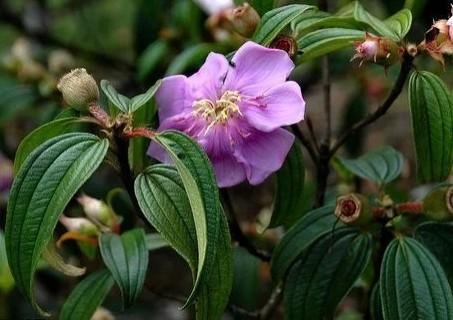Plants harendong or sesuduk or kluruk, and many more other names, what are the benefits of this plant, here is more info!

A. THE CHARACTERS OF HARENDONG PLANTS
RING
upright shrubs as high as 0.5m - 4m which are branched up and can grow in places that get enough sunlight such as on mountain slopes, bushes, less arid fields.
LEAF
The leaves are single, stemmed, opposite and round-shaped with a pointed tip, rounded base, flat edges, rare and rigid short-haired surfaces that are palpable with 3 arched bones, 2 - 20 cm long, 0.75 - 8.5 cm, the color is green.
FLOWER
The flowers come out at the end of the branch, a flat panicle with the number of flowers per panicle 4-18 reddish purple, the flower stands alone with a beautiful shape.
FRUIT AND SEEDS
The fruit is red, oval, and small ± 6 mm.
The seeds are small, the color is brown. The fruit can be eaten, while the young leaves can be eaten as a vegetable or vegetable.

DESCRIPTION OF HARENDONG PLANTS
Indigenous plants grow wild in the fields or on the edge of the swamps, or planted in tourist areas as ornamental plants at an altitude of up to 1650 above sea level.
Senggani extract can be used for analgesic substances as pain relievers, urinary peluruh, eliminate swelling and stop bleeding.
Treatable diseases: indigestion (dyspeptic), bacillary dysentery, diarrhea, hepatitis,; Whitish (leukorea), canker sores, excessive menstruation, blood hemorrhoids,; Uterine bleeding, dysentation (melena), poisoning of cassava,; Inflammation of the walls of blood vessels; freezing (thromboangitis);
B. CONTENT OF THE HARENDONG PLANT POWER
Composition: Chemical Properties and Pharmacological Effects: Senggani Leaf tastes bitter.
Chemical content: The senggani leaves contain saponins, flavonoids, and tannins.
Leaves and roots contain tanners.
C. KHASIAT AND BENEFITS OF HARENDONG
Senggani efficacious to overcome: food digestive disorders (disepsi), dysentery basiler, diarrhea, hepatitis, leucorrhoea (leukorea), canker sores, excessive menstrual blood, uterine bleeding outside the time of menstruation, nosebleeds, dysentery (blood), hemorrhoids bleeding, inflammation of the wall, blood vessels with blood clots in the tract (thromboangitis), breast milk (milk) is not smooth, cassava poisoning, drunk liquor, water bollard, and ulcers.
APPLICATION OF HEAVY PLANTS AS MEDICINE DRUGS
Epilepsy: 8 pieces of root, washed, and plaited. Then boiled with 600 ml of water until the remaining half. Strain and drink 2x a day (150 ml).
Medicinal Whitish: Fresh senggani leaves as much as 2 handheld, ginger, and bengle each the size of thumbs washed and then cut into pieces as needed. Add 3 cups of water and 1 tablespoon of vinegar, then boil until the water remaining 2 cups. After chilling filtered, then drink 2 times a day, each 1 cup.
Ginger and bengle can be replaced with 3 buds of cempaka and 3 pieces of old betel nut.
Basiler dysentery: senggani leaves and aseman (Polygonum chinense), each fresh ingredients of 60 g boiled with 3 cups of water until the remaining 1 cup. After cold filtered, then drink at once
Sariawan medicine: 2 pieces of young senggani leaves 2 washed and rinsed with boiled water. The leaves are then chewed with a pinch of salt, then the water is swallowed
Medication Boils: Fresh senggani leaves 50 g boiled. Boiled water drunk, arnpasnya crushed and affixed on boils, then bandaged.
Neutralize toxins: Cassava Roots or senggani leaves as much as 60 g boiled with 3 cups water until the remaining 1 cup. After the cold is filtered then drink at once.
Uterine bleeding: 15 pieces of senggani seeds (fried without oil) until black then boiled with 2 cups water until the remaining 1 cup. After chilling filtered and drink 2 times a day, each 1/2 cup. Do it every day until cured.
thank you very much already reading. hopefully this post is useful for all steemit friends. is not it better to prevent than to cure ..
Nice post my bro, keep focus!!!
Ok.bro.hehee